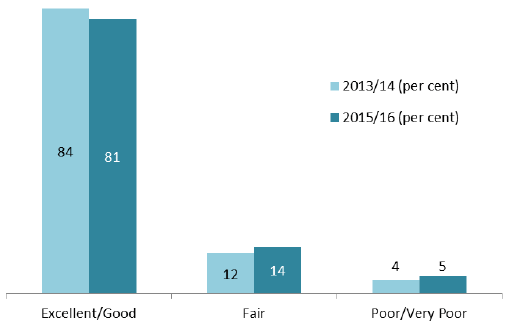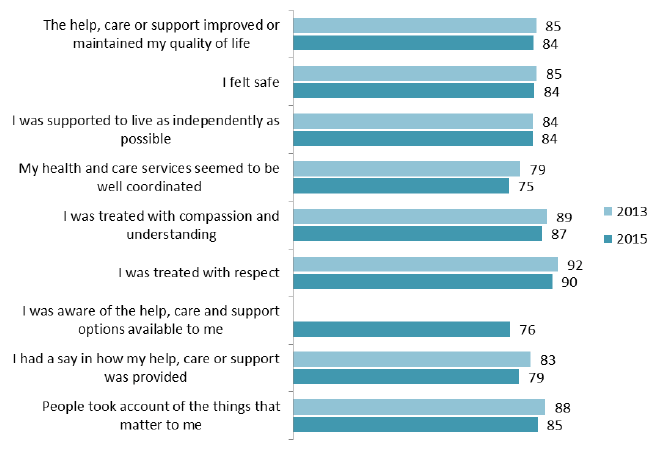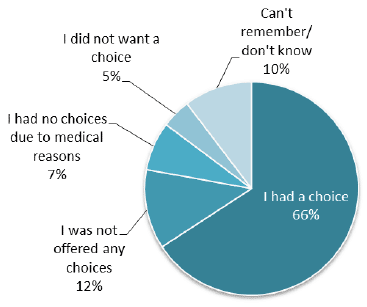Health and Care Experience Survey 2015/16 - National Results
Results from the 2015/16 Health and Care Experience Survey.
This document is part of a collection
11 Care, Support and Help With Everyday Living
Summary
- Many people who get support for everyday living receive this outside of formal services - 43 per cent indicated that their help did not come from formal services.
- Of those who received formal help and support, 81 per cent rated the overall help, care or support services as either excellent or good. This is a decrease from 84 per cent in 2013/14.
- As in the last survey, users of care services were most positive about some person-centred aspects of care. Ninety per cent reported that they were treated with respect.
- Users of care services were least positive about coordination of health and care services. Seventy five per cent reported that services were well coordinated, which is a decrease of four percentage points from 2013/14.
- There was considerable variation across Scotland in experiences of care services, especially around co-ordination of health and care services and awareness of the help, care and support options that are available.
Introduction
11.1 Chapter 4 of this report describes the wide reaching and ambitious programme of reform which has been put in place to improve services for people who require health and social care support. This focuses on the aim of providing joined up care provision and, crucially, empowering people to be in control of the support that they receive. These reforms are being delivered through newly created Health and Social Care Partnerships. Whilst a number of these Partnerships were established in 2015, for the most part this survey took place before health and social care integration was fully in place, and the results should be interpreted in that context.
11.2 This survey includes questions about experiences of care and support to inform these aspirations, in particular focusing on feeling safe, quality of life, being treated with respect and having a choice in care and support provision. These questions were first asked in the 2013/14 survey and were repeated in 2015/16.
Use of care services
11.3 Respondents were asked to indicate if they had received any help or support for everyday living in the last 12 months and the type of support they received. Of those surveyed, 13 per cent said that they had received some form of support; Table 11 below details the different type(s) of support. Two per cent said that they had not received any help but felt that they needed it. These are similar percentages to those reported in the previous survey.
Table 11: In the last 12 months have you had help or support with everyday living?
(note that respondents were able to select one or more of these options)
| Help required | % |
|---|---|
| Yes, personal and or household tasks | 8 |
| Yes, adaptations/equipment for home | 5 |
| Yes, activities outside home | 4 |
| Yes, help to look after someone else | 3 |
| No, not had any help, but felt I needed it | 2 |
| No, not had any help | 76 |
| Response missing or invalid | 10 |
11.4 Respondents who indicated that they received help and support for everyday living were asked whether this was from formal services [21] . Fifty seven per cent of those who need help with everyday living said that their help was provided by formal services, suggesting that a sizeable proportion of people (43 per cent) receive assistance with everyday living outside of formal service provision, perhaps from friends and family. This finding underlines the important contribution of unpaid carers to society in providing care to those that need it. In recognition of this, a major policy focus in recent years has been to enhance ways of protecting and supporting carers (see Section 12 on carers' experiences).
Experiences of care services
11.5 Respondents who indicated that they had received help and support from formal services were asked to rate their overall experiences of these services. In total 81 per cent of respondents rated the overall help, care or support services as either excellent or good, which is a decrease from 84 per cent in 2013/14. Five per cent rated it as poor or very poor (Figure 20).
11.6 There was wide variation in experience between Health & Social Care Partnerships, with results ranging from 73 per cent to 88 per cent. A fuller analysis of variations in care experience will be undertaken and published in Autumn 2016.
Figure 20: Overall, how would you rate your help, care or support services?

11.7 Looking at the reported experiences of specific aspects of care and support (Figure 21), respondents were less positive about the co-ordination of health and care services in particular. This was the lowest scoring statement, with 75 per cent positive response in 2015/16 which is four percentage points lower than the equivalent figure in 2013/14. A new question, which asked whether people were aware of the help, care and support options available, had a similar level of positive response of 76 per cent. These aspects of care provision also had the widest variation in experiences between Health & Social Care Partnerships; positive results for service co-ordination varied from 60 per cent to 85 per cent.
Figure 21: Percentage of people strongly agreeing/agreeing with statements about the help, care and support that they receive

11.8 Respondents were also less positive in this survey about their experiences of influencing how care is provided than they were in 2013/14. Seventy nine per cent indicated that they had a say in how their help, care or support was provided, which is a 4 percentage point decrease since 2013/14. A new question in 2015/16 specifically asked respondents whether or not they had a choice in how their social care was arranged (Figure 22). Twelve per cent of respondents said that they were not offered any choices in their care, seven per cent said that they had no choice due to medical reasons and four per cent said that they didn't want a choice.
Figure 22: Which of the following applies to your and how your social care is arranged?

11.9 Respondents remained very positive, however, about some of the person-centred aspects of the care that they received. Ninety per cent reported that they were treated with respect, while 87 per cent indicated that they were treated with compassion and understanding. Respondents also tended to be positive about service providers taking account of their preferences and values, although less so than in 2013/14. Eighty five per cent reported that people took account of the things that matter to them.
Contact
There is a problem
Thanks for your feedback